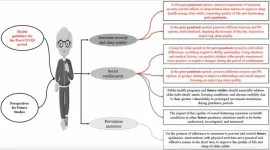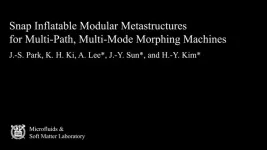(Press-News.org) Cambridge, MA – Insilico Medicine ( “Insilico”) , a clinical stage generative artificial intelligence (AI)-driven biotechnology company today announced a set of preclinical drug discovery benchmarks from the 22 developmental candidate nominations achieved by its platform from 2021 to 2024. These benchmarks underscore the platform's efficiency and represent a potential new standard for the drug discovery industry by significantly reducing developmental times, cost, and by allowing resources to be redirected toward further research and development.
The promise of AI-powered drug discovery (AIDD) has always revolved around three factors: speed, cost, and the probability of success. Tens of billions of dollars have been invested in AIDD since the dawn of the deep learning revolution, which started with notable achievements where deep neural networks (DNNs) came close to or exceeded human capabilities in the ImageNet competition, “Atari Game”, and other notable demonstrations.
Insilico Medicine started in 2014, and until 2019 bootstrapped solving complex problems across end-to-end drug discovery and development for big pharmaceutical, biotechnology, and consumer companies, prioritizing projects focusing on longitudinal data. In 2019, Insilico published its Generative Tensorial Reinforcement Learning (GENTRL) concept in Nature Biotechnology with experimental validation setting a benchmark of 46-days from project initiation to animal pharmacokinetic (PK) studies, including synthesis and multiple preclinical assays. These demonstrations were followed by Insilico’s first large $37 million Series B financing round announced in September 2019, which launched the AI software business and started Insilico’s internal drug discovery program. In February 2021, Insilico Medicine nominated its first developmental candidate in lung fibrosis, setting a benchmark of 18 months from project initiation to DC nomination.
By December 31, 2024, Insilico Medicine nominated 22 developmental candidates, with 10 programs progressing to human clinical stage, completed 4 Phase I clinical studies, and completed 1 Phase IIa study in idiopathic pulmonary fibrosis (IPF) - demonstrating good safety and dose-dependent efficacy.
In this release, Insilico Medicine announces its internal benchmarks for DC nomination timelines as well as how these developmental candidates are defined.
The terminology and standards for preclinical milestones vary from company to company. Insilico defines the typical developmental candidate (DC) as the stage after which only IND-enabling study remains before the drug enters human clinical trials. The typical DC package at Insilico Medicine specifically includes, but is not limited to, the following components:
Enzymatic assays demonstrating binding affinity
In vitro ADME profile
Microsomal stability assays
Mouse/rat/dog pharmacokinetic (PK) studies
Cellular functional assays and PD marker validation demonstrating target engagement
In vivo efficacy studies and PK/PD/efficacy analysis demonstrating target engagement and identifying efficacious dose ranges
non-GLP toxicity studies across multiple species
Benchmarks:
Insilico has now officially announced key timeline benchmarks for its 22 developmental candidates, emphasizing its commitment to efficiency, transparency and innovation in drug development:
# of Developmental Candidate Nominations (2021–2024): 22 candidates
Longest time to DC: 18 months; 79 molecules synthesized
Average time to DC: ~13 months; ~70 molecules synthesized per program
Shortest time to DC: 9 months
QPCTL program co-developed with Fosun Pharma and in ongoing Phase I trial
The success rate for advancing programs from the developmental candidate stage to the IND-enabling stage has been 100%, excluding programs that were voluntarily discontinued by the company for strategic reasons.
These benchmarks reflect a significantly more efficient approach compared to traditional drug discovery methods, which often require significantly longer timelines (2.5-4 years) and greater resource expenditure. Insilico’s integration of AI and automation streamlines candidate selection and synthesis, demonstrating how innovative approaches can shorten preclinical development timelines.
Benchmarking Case Studies:
A compelling case study highlighting the benchmarks of Insilico Medicine's developmental candidate package was published earlier in 2024, with a Nature Biotechnology Paper presenting the entire R&D journey from AI algorithms to Phase II clinical trials of ISM001_055, the company's lead drug program with an AI-discovered target and AI-generated design. Following that, Insilico recently announced positive topline results from a Phase IIa trial, where ISM001_055 showed favorable safety and tolerability across all dose levels, as well as dose-dependent response in forced vital capacity (FVC), after only 12 weeks of dosage.
A second case study highlighting the benchmarks set by Insilico Medicine's platform was published in another Nature Biotechnology Paper in December 2024, highlighting the 12 month timeline it took to synthesize and screen approximately 115 molecules, supported by its integrated generative chemistry engine. The paper outlines the early drug discovery and development process and preclinical data of ISM5411. Following that, two separate Phase I studies conducted in Australia and in China indicated that ISM5411 was generally safe and well tolerated in all dose groups, demonstrating a favorable PK profile in validating gut-restrictive properties.
Insilico Medicine remains steadfast in its commitment to transparency throughout the drug discovery process, recognizing the critical role it plays in advancing global innovation. By openly sharing benchmarks, including developmental candidate timelines and synthesis data, Insilico aims to demonstrate how shedding light on these metrics can drive efficiency across the industry. Transparent reporting not only highlights the capabilities of advanced AI-driven platforms but also underscores the urgency of accelerating the journey from discovery to clinical trials. Ultimately, such efforts enhance global productivity in pharmaceutical development and bring life-saving therapies to patients more rapidly.
New Therapeutic Areas:
Several recent breakthroughs at Insilico Medicine have led to the development of strong preclinical assets targeting a new focus on pain, obesity and muscle wasting. Multiple preclinical models have shown encouraging results and supported the planning of a next-generation pipeline highlighted by iNAPs - Insilico non-addictive anti-pain therapeutics.
Chronic pain, obesity, and muscle wasting represent significant unmet medical needs, with millions of patients worldwide lacking effective, safe, and accessible treatment options. Current pain management strategies often rely on addictive opioids, contributing to a global epidemic of dependency and overdose. Similarly, therapies for obesity are limited in their efficacy and tolerability, while muscle-wasting conditions often go unaddressed due to a lack of targeted treatments. Insilico Medicine's pivot into these areas signifies a commitment to addressing these critical gaps in care. Leveraging its AI-driven platforms, Insilico aims to rapidly advance the development of novel therapeutics, such as iNAPs, which promise non-addictive, targeted mechanisms of action for pain relief. By integrating cutting-edge computational biology, chemistry, and experimental validation, Insilico seeks to not only accelerate drug discovery timelines but also redefine therapeutic possibilities in these areas, bringing hope to patients with few or no viable options.
Reference
[1] Fu, Y., Ding, X., Zhang, M. et al. Intestinal mucosal barrier repair and immune regulation with an AI-developed gut-restricted PHD inhibitor. Nat Biotechnol (2024). https://doi.org/10.1038/s41587-024-02503-w
[2] Ren, F., Aliper, A., Chen, J. et al. A small-molecule TNIK inhibitor targets fibrosis in preclinical and clinical models. Nat Biotechnol (2024). https://doi.org/10.1038/s41587-024-02143-0
About Insilico Medicine
Insilico Medicine, a global clinical stage biotechnology company powered by generative AI, is connecting biology, chemistry and clinical trials analysis using next-generation AI systems. The company has developed AI platforms that utilize deep generative models, reinforcement learning, transformers and other modern machine learning techniques for novel target discovery and the generation of novel molecular structures with desired properties. Insilico Medicine is developing breakthrough solutions to discover and develop innovative drugs for cancer, fibrosis, immunity, central nervous system diseases, infectious diseases, autoimmune diseases, and aging-related diseases.
www.insilico.com
END
Insilico Medicine announces developmental candidate benchmarks and timelines for novel therapeutics discovered using generative AI
2025-02-11
ELSE PRESS RELEASES FROM THIS DATE:
A wealth of evidence: PIK compiles 85,000 individual studies about climate policy
2025-02-11
“Rather than directly providing answers to questions about the effects of climate policies, this study displays an overview of what has actually been scientifically studied so far,” explains Max Callaghan, PIK researcher and lead author of the study. “On the one hand, this informs existing gaps and thus directions for primary research, including through funding. On the other hand, this overview facilitates evidence synthesis work, i.e. the summarisation of the state of knowledge for governments, for example in the IPCC Assessment Reports.”
The study shows, among other ...
New fish species with ‘face paint’ named after Studio Ghibli character
2025-02-11
Researchers in China have named a newly discovered fish species after the Studio Ghibli character San from Princess Mononoke based on its similar facial markings.
Published in the open-access journal ZooKeys, Branchiostegus sanae is a deepwater tilefish belonging to the family Branchiostegidae. It was discovered when scientists noticed unique cheek pattern on some deepwater tilefish individuals in online seafood markets.
The research team used genetic analysis to confirm the new-species status of the fish, and were inspired by its facial stripes to name it after the female protagonist, San, from Hayao Miyazaki’s animated film Princess Mononoke, choosing “sanae” ...
Mechanical heart valve replacements have better long-term survival, study finds
2025-02-11
Patients aged between 50 to 70 years with a mechanical heart valve replacement had better long-term survival compared to those with a biological valve, new research led by the University of Bristol has found. The study is published in the European Journal of Cardio-Thoracic Surgery.
The last two decades have seen an increase in the use of biological over mechanical heart valve replacements. However, while short-term clinical outcomes are known to be the same, long-term outcomes are still under debate.
Existing guidelines support the use of mechanical valves made of synthetic ...
Sandra Diaz and Eduardo Brondízio, scholars of human-nature interconnection, win the 2025 Tyler Prize with call for policies, business models and individuals to recognize humanity’s 'entanglement' wit
2025-02-11
FEBRUARY 11, 2025 – Argentine ecologist Sandra Díaz and Brazilian-American anthropologist Eduardo Brondízio are being awarded the 2025 Tyler Prize for Environmental Achievement for their extraordinary work linking biodiversity to humankind, the Tyler Prize Executive Committee announced today.
Díaz and Brondízio are using the win to draw attention to humanity’s “entanglement” with nature in a joint call for policies, business models, and individuals to acknowledge their dependence and shared responsibility in the “fabric of life.”
“The ...
Kessler Foundation in partnership with Overlook Medical Center is first in NJ to implant novel spinal stimulator
2025-02-11
East Hanover & Summit, NJ – February 11, 2025 – The Tim and Caroline Reynolds Center for Spinal Stimulation at Kessler Foundation is proud to announce the implantation of a spinal cord epidural stimulator in an individual with paralysis, marking a significant advancement in spinal cord injury treatment and rehabilitation. The surgical procedure was funded by the Joseph and Cheryl Marino Family Foundation and performed by neurosurgeon Robert F. Heary, MD, at Overlook Medical Center in Summit, NJ, part of Atlantic Health System, home of the Atlantic Neuroscience Institute.
This groundbreaking procedure, ...
Study reveals how physical activity impacts sleep quality in older adults during COVID-19 pandemic
2025-02-11
“[…] we found that PA may be associated with the sleep quality of older adults during the COVID-19 pandemic and that reduced levels of PA during the COVID-19 pandemic period had a negative association with the quality of sleep of older adults in social isolation.”
BUFFALO, NY—February 11, 2025 — A new research paper was published in Aging (Aging-US) on January 15, 2025, in Volume 17, Issue 1, titled “Association between physical activity practice and sleep quality of older people in social isolation during the COVID-19 pandemic and Health Guidelines and future studies ...
ADHD symptoms and later e-cigarette and tobacco use in youths
2025-02-11
About The Study: In this cohort study of U.S. youths, attention-deficit/hyperactivity disorder (ADHD) symptoms were associated with the onset of nicotine and tobacco use. The findings highlight the importance of early diagnosis and effective treatment of ADHD to alleviate symptoms and reduce the risk of later nicotine and tobacco use.
Corresponding Author: To contact the corresponding author, Sean Esteban McCabe, PhD, email plius@umich.edu.
To access the embargoed study: Visit our For The Media ...
Prepandemic prevalence of dietary supplement use for immune benefits
2025-02-11
About The Study: This study has 3 findings in a prepandemic context. First, approximately 1 in 9 U.S. residents used a dietary supplement for perceived immune benefits (supplements to prevent colds or boost the immune system), and such usage varied by several sociodemographic and health characteristics. Second, label claims related to immune benefits consistently appeared on over half of dietary supplements taken for perceived immune benefits. Lastly, the prevalence of dietary supplement use for perceived immune benefits due to a doctor recommendation and dietary supplement use exclusively for perceived immune benefits were both generally ...
Born to heal: Why babies recover, but adults scar, after heart damage
2025-02-11
Study in experimental animals reveals fundamental differences in how immune system drives healing based on age
Newborn immune systems see, then eat dying cells, triggering production of bioactive lipids
Findings open the door to developing treatments that could ‘reprogram’ adult immune systems
CHICAGO --- Newborns with heart complications can rely on their newly developed immune systems to regenerate cardiac tissues, but adults aren’t so lucky. After a heart attack, most adults struggle to regenerate healthy heart tissue, leading ...
SNU researchers develop soft robot that crawls, climbs, and shape-shifts to move in new directions
2025-02-11
A new type of soft robot can crawl like a worm, climb cables, and suddenly snap into a completely different shape to move in a new direction—all controlled by a single air input. This breakthrough, developed by researchers at Seoul National University, introduces a fundamentally new way for soft robots to move and adapt to their surroundings.
A Leap Forward in Soft Robotics
Soft robots, made from flexible materials, are known for their ability to bend and stretch. However, until now, they struggled to precisely control motion and required complex ...




